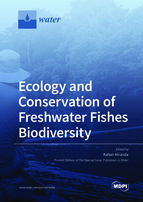Ecology and Conservation of Freshwater Fishes Biodiversity
A special issue of Water (ISSN 2073-4441). This special issue belongs to the section "Biodiversity and Functionality of Aquatic Ecosystems".
Deadline for manuscript submissions: closed (31 December 2020) | Viewed by 52548
Special Issue Editor
Interests: freshwater fishes; hydrobiology; limnology; management and conservation wildlife; animal ecology; conservation biology; biological invasions
Special Issues, Collections and Topics in MDPI journals
Special Issue Information
Dear Colleagues,
Fishes are a highly diverse group of Chordata, with more than 33,500 species, a larger number than that of all non-fish vertebrates combined. Freshwater fishes comprise more than 16,000 species, distributed throughout the planet. Freshwater fishes are one of the most endangered group of vertebrates, especially vulnerable to human alterations as a result of species introduction, overexploitation, fragmentation, degradation of continental watercourses, and climate change. However, knowledge of ecology and conservation status of freshwater fishes is lower than for terrestrial groups due to bias in conservation research toward those charismatic species. Research into environmental requirements, ecological issues, and threats of freshwater fishes is considered essential to be able to develop adequate management plans for freshwater ecosystems. Understanding these ecological features remains a key concern of conservation biology.
The aim of this Special Issue of Water is to explore these topics: The analysis of environmental issues related to freshwater fish biodiversity and human impacts, focused on the conservation biology of species and ecosystems.
Prof. Dr. Rafael Miranda
Guest Editor
Manuscript Submission Information
Manuscripts should be submitted online at www.mdpi.com by registering and logging in to this website. Once you are registered, click here to go to the submission form. Manuscripts can be submitted until the deadline. All submissions that pass pre-check are peer-reviewed. Accepted papers will be published continuously in the journal (as soon as accepted) and will be listed together on the special issue website. Research articles, review articles as well as short communications are invited. For planned papers, a title and short abstract (about 100 words) can be sent to the Editorial Office for announcement on this website.
Submitted manuscripts should not have been published previously, nor be under consideration for publication elsewhere (except conference proceedings papers). All manuscripts are thoroughly refereed through a single-blind peer-review process. A guide for authors and other relevant information for submission of manuscripts is available on the Instructions for Authors page. Water is an international peer-reviewed open access semimonthly journal published by MDPI.
Please visit the Instructions for Authors page before submitting a manuscript. The Article Processing Charge (APC) for publication in this open access journal is 2600 CHF (Swiss Francs). Submitted papers should be well formatted and use good English. Authors may use MDPI's English editing service prior to publication or during author revisions.
Keywords
- Habitats and ecosystems
- Threatened species
- Conservation planning
- Climate change
- Limnology
- Environmental water quality






